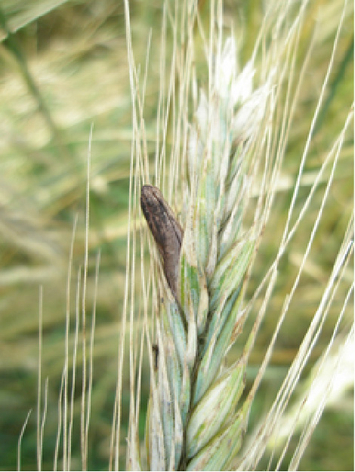Ergot
Claviceps purpurea
Biology
Ergot belongs to the group of tubular fungi (Ascomycota) and overwinters in the form of permanent forms (sclerotia) that reach the soil during the threshing process. In spring, several stalked heads with numerous fruiting bodies (perithecia) germinate from the sclerotia remaining on the soil surface, in which the tubular spore tubes (asci) are found. Spores are ejected from these spore tubes during humid weather. These spores reach the unfertilized stigmas during flowering of cereals and grasses by means of wind. Egress subsequently occurs with assimilate droplets from the flower. Through the asexually formed spores (conidia), the fungus is further spread by insects, wind, rain, or contact to other unfertilized stigmas. This infection period is prolonged when little pollen is available due to cultivar characteristics or poor weather. In the infected flowers, the typical sclerotia of the ergot fungus subsequently develop instead of grains.
Mainly in the Middle Ages, the consumption of bread made from ergot-infected grain repeatedly led to mass poisoning of entire cities. The toxic effect of ergot is due to its high alkaloid content. At that time, the poisonings were referred to as Antonius fires. The name ergot also refers to the alkaloids (here especially ergometrine), which stimulate labor and were used for abortions.
Damage symptoms


Already during flowering, the first symptoms of ergot are yellowish drops on the inflorescences. These are the assimilate drops that emerge from the flower and are known as honeydew. As the grain matures, the dark brown to dark purple colored permanent forms (sclerotia) appear. These curved formations are usually much larger than the grain kernel and thus very conspicuous. Depending on the host plant, ergot sclerotia can grow to between a few millimeters and several centimeters in size.
Prevention and control
Ergot, unlike many other fungal pathogens, cannot be controlled directly with pesticides. The following measures can reduce possible infestation:
- Reduce the proportion of rye in the crop rotation.
- Use of ergot-free seed
- Deep plowing after rye to bury the sclerotia and weaken their ability to germinate. This is especially true if ergot infestation has been detected
- Preventing grasses from flowering at the edges of fields by mowing them down can also reduce infestations
Specialized information
In the Austrian Descriptive List of Varieties there is a classification of susceptibility of rye varieties to ergot.
Last updated: 02.10.2025
automatically translated